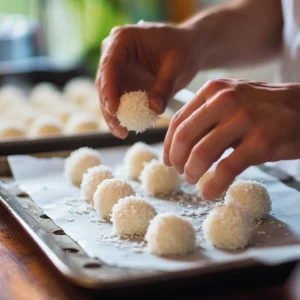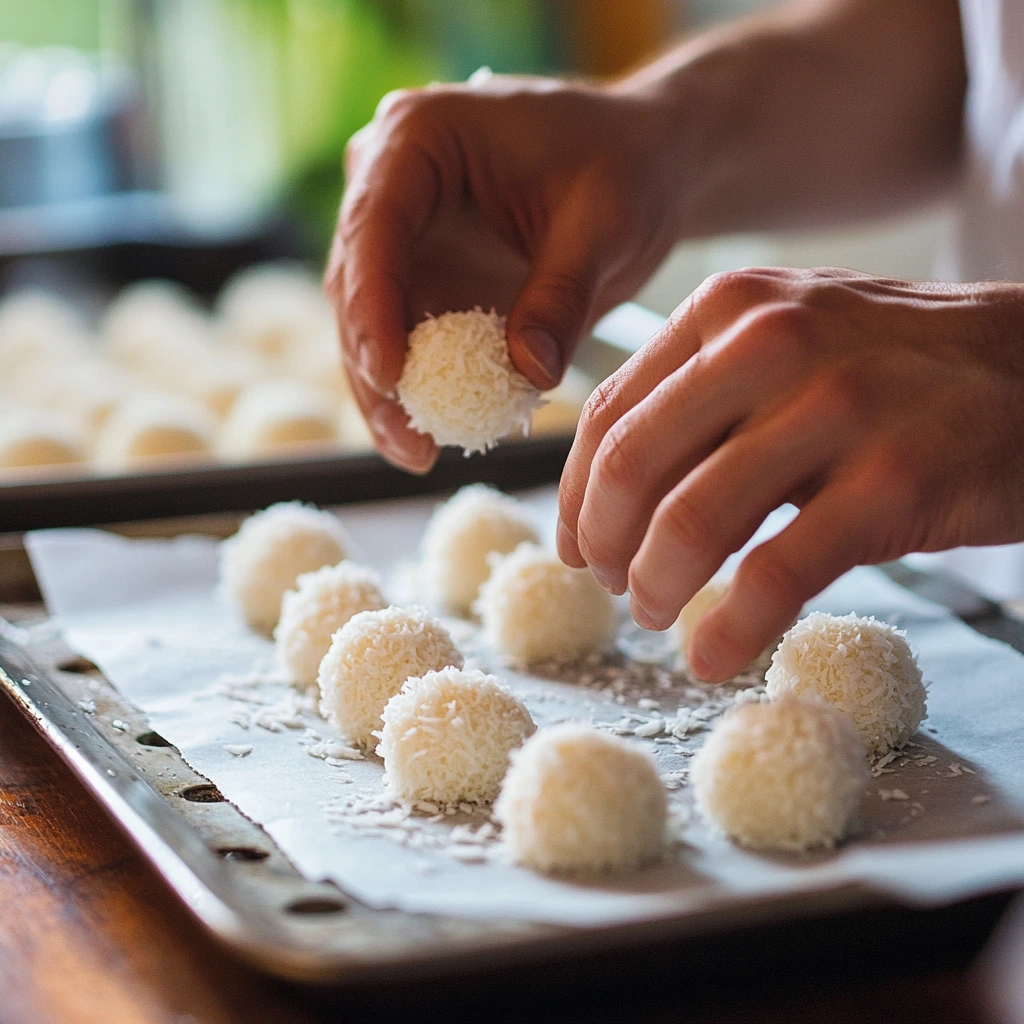If you’ve got a sweet tooth and a love for tropical flavors, coconut candy is about to become your new favorite treat! This delightful confection balances the natural richness of grated coconut with just the right amount of sweetness, creating an irresistible bite-sized indulgence. Whether chewy, crunchy, or smooth, every variation celebrates the pure, nutty goodness of coconut.
The Story Behind Coconut Candy
Coconut candy isn’t just a delicious treat—it carries a cultural legacy in many tropical regions around the world. From street vendors in Ghana to bustling markets in Vietnam, these candies reflect local artistry and tradition. Shaped into bite-sized bars, rolled into neat little balls, or cut into intricate designs, each batch is a testament to the skill of its maker.
Modern twists have only enhanced its appeal, with flavors like vanilla, chocolate, and pandan giving this classic an exciting new edge. No matter the version, one thing is certain—coconut candy remains a cherished favorite across generations.
What Goes Into Coconut Candy?
Making coconut candy is surprisingly simple, requiring just a few staple ingredients that come together in the most delightful way.
Essential Ingredients:
- Coconut: Freshly grated coconut brings the best flavor, but desiccated coconut works great for convenience.
- Sugar: The key to the candy’s sweetness! Brown sugar adds a deep caramel flavor, while white sugar keeps it light.
- Extras: Condensed milk, butter, and vanilla extract enhance the texture and richness.
Want to shake things up? Try adding chocolate, pandan, or even fruit for a fun twist!
How Is Coconut Candy Made?
The process of making coconut candy is just as enjoyable as eating it! Here’s how it’s traditionally done:
- Grating the Coconut: First, crack open a mature coconut and grate the meat into fine shreds. This step ensures the freshest, richest flavor.
- Cooking the Mixture: Combine the grated coconut, sugar, and coconut milk in a saucepan. Stir continuously over medium heat to prevent burning. As the sugar melts, it transforms into a golden syrup, coating the coconut beautifully.
- Shaping & Cooling: Once thickened, pour the mixture onto a greased tray or into molds. Smooth it out, let it cool, then cut into bite-sized pieces or roll into balls.
Though it takes patience, the result—a chewy, flavorful candy—is absolutely worth it!
Coconut Candy Around the World
Different cultures put their own spin on this classic treat, making it even more exciting to explore!
- Vietnam – Kẹo Dừa: A melt-in-your-mouth version made with coconut milk and malt syrup, often wrapped in edible rice paper for extra crunch.
- Brazil – Cocada: A baked version that ranges from chewy to crispy, sometimes featuring condensed milk, eggs, or tropical fruits.
- Ghana – Kube Cake: A caramelized delight made with coconut and sugar, with a hint of lemon for a tangy twist.
Each regional version tells a story of tradition, creativity, and a love for coconut!
Make Your Own Coconut Candy
Simple No-Bake Coconut Candy
A quick and easy way to enjoy this treat without turning on the stove!
Ingredients:
- 2 cups desiccated coconut
- 1 cup sweetened condensed milk
- 1 teaspoon vanilla extract
- A pinch of salt
Instructions:
- Mix all ingredients in a bowl until well combined.
- Roll the mixture into small balls or press it into a dish and cut into bars.
- Refrigerate for 2 hours, then enjoy!
Traditional Cooked Coconut Candy
For those who love a classic, this version captures the nostalgic taste of homemade coconut candy.
Ingredients:
- 2 cups freshly grated coconut
- 1 ½ cups granulated sugar
- ½ cup coconut milk
- Edible rice paper (optional)
Instructions:
- In a saucepan, combine all ingredients and stir continuously over medium heat.
- Let the mixture cook until thick and golden brown (about 20-30 minutes).
- Spread onto a greased tray or edible rice paper, flatten, and cool completely.
- Cut into bite-sized pieces and store in an airtight container.

Health Perks (and Considerations)
Coconut candy may be a sweet indulgence, but it does have some surprising benefits when enjoyed in moderation!
✅ Rich in Fiber: Coconut meat provides dietary fiber, promoting healthy digestion.
✅ Quick Energy Source: Medium-chain fatty acids (MCFAs) in coconut are metabolized quickly, offering a fast energy boost.
✅ Satisfying Sweetness: Thanks to its dense texture, a small piece goes a long way in satisfying cravings!
That said, coconut candy is also high in sugar and saturated fat, so portion control is key. To make it healthier, try reducing sugar or using natural sweeteners!
Learn more about coconut nutrition here.

Coconut Candy Around the World
Different cultures put their own spin on this classic treat, making it even more exciting to explore!
- Vietnam – Kẹo Dừa: A melt-in-your-mouth version made with coconut milk and malt syrup, often wrapped in edible rice paper for extra crunch.
- Brazil – Cocada: A baked version that ranges from chewy to crispy, sometimes featuring condensed milk, eggs, or tropical fruits.
- Ghana – Kube Cake: A caramelized delight made with coconut and sugar, with a hint of lemon for a tangy twist.
Each regional version tells a story of tradition, creativity, and a love for coconut!

Make Your Own Coconut Candy
Simple No-Bake Coconut Candy
A quick and easy way to enjoy this treat without turning on the stove!
Ingredients:
- 2 cups desiccated coconut
- 1 cup sweetened condensed milk
- 1 teaspoon vanilla extract
- A pinch of salt
Instructions:
- Mix all ingredients in a bowl until well combined.
- Roll the mixture into small balls or press it into a dish and cut into bars.
- Refrigerate for 2 hours, then enjoy!

Traditional Cooked Coconut Candy
For those who love a classic, this version captures the nostalgic taste of homemade coconut candy.
Ingredients:
- 2 cups freshly grated coconut
- 1 ½ cups granulated sugar
- ½ cup coconut milk
- Edible rice paper (optional)
Instructions:
- In a saucepan, combine all ingredients and stir continuously over medium heat.
- Let the mixture cook until thick and golden brown (about 20-30 minutes).
- Spread onto a greased tray or edible rice paper, flatten, and cool completely.
- Cut into bite-sized pieces and store in an airtight container.

.FAQs About Coconut Candy
What is Mexican coconut candy made of?
Mexican cocada typically consists of shredded coconut, sugar, and condensed milk, often flavored with cinnamon or vanilla.
Is coconut candy healthy?
While it provides fiber and quick energy, coconut candy is high in sugar and fat, so moderation is best.
What’s in Vietnamese coconut candy?
Vietnamese kẹo dừa is made with coconut milk, sugar, and malt syrup, giving it a smooth, chewy texture.
Final Thoughts
Coconut candy is more than just a sweet snack—it’s a taste of tradition, creativity, and nostalgia. Whether you prefer it chewy, crunchy, or creamy, there’s a version out there for everyone. Try making it at home and bring
For more inspiration and creative ideas, don’t miss our latest article: Horchata History, Recipes & Health Benefits. It’s packed with fresh recipes and tips to make your cooking experience even more enjoyable!
Experiment with flavors, share your creations with loved ones, and enjoy the timeless charm of coconut candy. Stay tuned for more recipes and insights!

Simple No-Bake Coconut Candy
Ingredients
- 2 cups desiccated coconut
- 1 cup sweetened condensed milk
- 1 teaspoon vanilla extract
- 1 pinch salt
Instructions
- Mix all ingredients in a bowl until well combined.
- Roll the mixture into small balls or press it into a dish and cut into bars.
- Refrigerate for 2 hours, then enjoy!


1 thought on “Ultimate Irresistible Coconut Candy: A Sweet, Crunchy Delight”